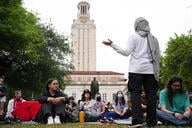You have /5 articles left.
Sign up for a free account or log in.
The comparatively dismal state of educational attainment for American Indians is well-established: They are almost twice as likely as other Americans not to have graduated from high school, significantly less likely to have any higher education, and half as likely to have a bachelor's degree.
The institutions most associated with educating Native Americans at the postsecondary level are the more than two dozen federally chartered tribal colleges and universities. They get the vast majority of their support from the federal government, receiving a total of nearly $100 million in operating funds each year through the Labor Department’s Bureau of Indian Affairs, and a significantly smaller amount for programs and facilities through the Education Department’s Strengthening Tribally Controlled Colleges and Universities program. For 2008, President Bush’s budget proposed cutting those latter funds to $18.6 million from the $23.6 million awarded in 2007, "an unprecedented cut," as Jamie P. Merisotis, president of the Institute for Higher Education Policy," described it at a hearing before the Senate Committee on Indian Affairs this month.
The tribal colleges are not the only institutions with American Indian students, of course; public colleges and universities in states with large Native American populations, like Arizona, New Mexico and the Dakotas, enroll significant numbers of such students.
In recognition of that, a move is afoot in Congress that would provide federal support to non-tribal institutions that enroll significant numbers of Native American students – and the idea is dividing American Indian educators.
The proposal, which was advanced in the last two sessions of Congress as an amendment to legislation to renew the Higher Education Act by Sen. Jeff Bingaman (D-N.M.), would call for providing grants to colleges and universities where Native Americans make up at least 10 percent of the student body. The Senate Health, Education, Labor and Pensions Committee is expected to consider a new version of the Higher Education Act extension bill as soon as next week, and a spokeswoman for Bingaman said the senator would push the Native American provision.
Bingaman said the funds, which would be authorized as part of Title III of the Higher Education Act, whose purpose is “strengthening institutions,” would be similar to those that now support what the government calls “Hispanic-serving institutions” -- those that have significant numbers of Hispanic or Latino students. The money would support curricular and faculty developments, the purchase of books, and other purposes. The government, Bingaman said in a news release about the bill, “does not do enough to support colleges that serve Native Americans.”
Tribal college leaders certainly agree with that statement, and they are sympathetic to the legislation’s goal of supporting Native American students, “many of whom are our graduates,” David Gipp, president of United Tribes Technical College, said at this month's hearing before the Senate Committee on Indian Affairs.
But Gipp and other tribal college leaders, as represented by the American Indian Higher Education Consortium, are troubled by several aspects of the proposed legislation. First, they are concerned that creating such a program would open the door to potential legal challenges to programs for Native Americans, where they believe none exist now. The current law that provides for educational funds for American Indians, the Tribally Controlled College or University Assistance Act, exists because the federal government has accepted a binding political responsibility to support the tribes in exchange for having seized their land many years ago.
But creating a new program that supports students at traditional institutions based on their ethnicity would raise affirmative action issues, the Indian higher education consortium argued in a September 2005 letter opposing the Bingaman proposal then.
The tribal colleges also argue that it would be unfair for traditional institutions that already receive significant federal and state support based on their enrollments to receive extra funds for enrolling Native American students, when tribal colleges cannot count the 20 percent of non-Indian students who make up their student bodies in the formula used to determine how much federal operating support they receive.
And because there would be “no practical way of separating out funds going to improve education opportunities Native Americans within these state institutions” that might receive funds under the Bingaman proposal, AIHEC argues, “this program would just result in creating a source of additional funds for state supported institutions to increase their basic operating and program budgets – without any means for measuring its effect on Native American students.”
Lastly, Gipp and others note, given the current fiscal environment in Congress and the intense competition it has created for scarce funds, it seems possible if not likely that any money that might go toward the proposed new program would come out of the already insufficient funds Congress appropriates each year for tribal colleges. The Bingaman measure would “authorize” the allocation of new funds for Native American-serving institutions, but like all such legislation, it would only permit Congress to spend those funds, not actually provide them. That would fall to Congressional appropriators each year, and their track record has not been good, Gipp argues.
“It’s really asking tribal colleges to do something greatly unfair to them,” he said, “when Congress has never reached the existing funding levels.





